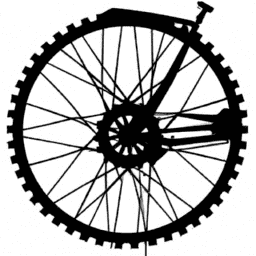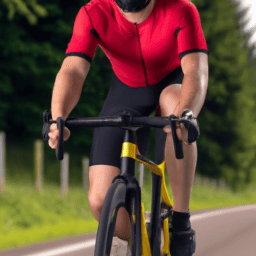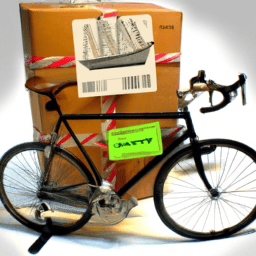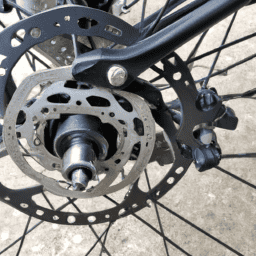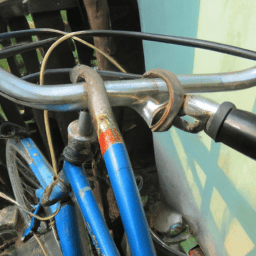I’ve been cycling for as far back as I can recall, and the engineering behind the braking systems has always captured my interest. Bicycles come equipped with various kinds of brakes, each presenting its own set of pros and cons.
In this article, I’ll be discussing coaster brakes, which are a common type of brake found on many bicycles, especially those of the cruiser or BMX style. Coaster brakes have been around for over a century and are still popular today.
They are a type of brake that is integrated into the rear wheel hub and activated by pedaling backward. This means that when you pedal backward, the brake engages and slows down or stops the bike. Coaster brakes are simple and easy to use, making them a popular choice for children’s bikes and casual riders. However, they do have some limitations, which I’ll explore in more detail later in the article.
Key Takeaways
- Coaster brakes are found on cruiser or BMX style bikes and are activated by pedaling backward.
- They are popular for children’s bikes and casual riders due to their simplicity and minimal maintenance.
- Coaster brakes have less stopping power and are less effective in wet or slippery conditions compared to disc brakes.
- When choosing brakes, it is important to consider riding style, terrain, and consult with a professional for installation or repairs.
Overview of Common Bicycle Brakes
You don’t want to be caught without knowledge of common bicycle brakes when you’re flying down a hill – so let’s start with an overview of the most popular ones, like coaster brakes.
Coaster brakes, also known as foot brakes, are a type of brake that is activated by pedaling backward. As you pedal backward, a mechanism inside the hub causes the brake shoes to press against the wheel rim, slowing down or stopping the bike. Coaster brakes are commonly found on cruiser bikes and children’s bikes, and they’re low-maintenance and easy to use.
Disc brakes are another popular type of bicycle brake, and they’re commonly used on mountain bikes and road bikes. Compared to coaster brakes, disc brakes offer more stopping power and better modulation, which means that you can apply the brakes more precisely. Disc brakes also perform better in wet or muddy conditions, making them a good choice for off-road riding.
Additionally, disc brakes come in two types of brake pads – organic and metallic. Organic brake pads are quieter and offer better modulation, while metallic brake pads last longer and offer better stopping power, but they can be noisier and wear down the rotor faster.
Now that we’ve covered the basics of common bicycle brakes, let’s take a look at the history and evolution of coaster brakes.
History and Evolution of Coaster Brakes
As the wheels turned and the rider’s feet pushed back, a new way of stopping emerged, evolving over time until it became the modern-day coaster brake. The development timeline of coaster brakes dates back to the late 1800s, when bicycle manufacturers experimented with various designs for a brake system that would be more convenient and efficient than the traditional rim brakes. In 1898, a patent was granted to Albert Overman for a "back-pedaling brake", which featured a band brake system that was activated by pedaling backward. This design was further improved by the Bendix Corporation in the 1930s, leading to the widespread use of coaster brakes in bicycles.
Technological advancements were crucial in the evolution of coaster brakes. The original band brake system was prone to slipping and overheating, which limited its effectiveness. To address these issues, manufacturers started using internal expanding shoes instead of bands, and added lubrication systems to prevent overheating. These improvements made coaster brakes more reliable and durable, and they became the preferred choice for many bicycle riders. Today, coaster brakes are still used in many bicycles, especially in children’s bikes and cruisers, and they remain an important part of the history and evolution of bicycle braking systems.
As we delve deeper into the mechanics of coaster brakes, it is important to understand the various components that make up this brake system.
How Coaster Brakes Work
So, let’s talk about how coaster brakes work. They rely on an internal gear mechanism that is activated by backpedaling. When you pedal forward, the brake mechanism disengages and the bike is free to move. However, when you backpedal, the mechanism engages and slows down or stops the bike.
It’s a simple yet effective system that has been around for over a century and remains a popular choice for many bikes today.
Internal Gear Mechanisms
With internal gear mechanisms, riders can effortlessly switch gears and enjoy a smooth ride without worrying about external factors affecting their bike’s performance. The benefits of internal gears are plenty, such as their ability to be enclosed in the hub of the rear wheel, which reduces the need for constant maintenance.
Unlike external gear mechanisms, internal gears are not exposed to the elements. This means less wear and tear, less dirt and debris getting into the gears, and less rusting. Maintenance of internal gears is also relatively easy because they do not require as much attention as external gears.
However, it is important to note that internal gears may require periodic adjustments to ensure they are working correctly. The process of adjusting internal gear mechanisms is similar to external gears, but it is less complicated and can be done with basic tools. Riders should still take their bike to a professional mechanic to ensure everything is working correctly, especially if they notice any unusual noises or difficulty shifting gears.
Moving on to the next subtopic, backpedaling activation is another feature of coaster brakes that makes them stand out from other types of brakes.
Backpedaling Activation
Backpedaling activation is one of the key features of coaster brakes on a bicycle. This means that instead of using your hands to engage the brakes, you can simply pedal backwards to slow down or stop.
As someone who’s been riding bikes for years, I’ve found this feature to be incredibly convenient. Here are a few backpedaling techniques and the advantages and disadvantages of coaster brakes for both beginners and experienced riders.
-
To slow down, you can pedal backwards gently. This is useful when you want to reduce speed but don’t need to come to a complete stop.
-
To stop completely, you can pedal backwards more forcefully until the bike comes to a halt. This is useful when you need to stop suddenly or in an emergency.
-
Coaster brakes are especially advantageous for beginners because they’re easy to use and require minimal maintenance.
-
However, experienced riders may prefer other types of brakes because coaster brakes can be less effective in wet or slippery conditions.
Overall, backpedaling activation adds a level of convenience to riding that can be especially beneficial for beginners. However, as we’ll discuss in the next section, coaster brakes also have their pros and cons.
Pros and Cons of Coaster Brakes
Riding a bicycle with coaster brakes can be a breeze, but it’s important to weigh the pros and cons before making a decision. Coaster brakes have been around for over a century, and they work by engaging the brake when you pedal backward. Although they are simple to use and require minimal maintenance, there are some advantages and disadvantages to consider.
On the one hand, coaster brakes are intuitive and require minimal effort to use. They are also low maintenance, as the brake mechanism is located inside the rear hub and is protected from the elements. However, coaster brakes can be less effective than other types of brakes, especially in wet or slippery conditions. They can also be more difficult to modulate, meaning it can be challenging to apply just the right amount of braking force. Additionally, coasting on a bicycle with coaster brakes can be less efficient, as the brake mechanism adds friction to the rear hub.
Transitioning to the next section, choosing the right brakes for your needs involves more than just considering the advantages and disadvantages of coaster brakes. There are several other types of brakes to choose from, each with their strengths and weaknesses.
Choosing the Right Brakes for Your Needs
When it comes to choosing the right brakes for my needs, I always consider my riding style, evaluate my terrain, and consult with a professional.
My riding style determines the type of brakes that will work best for me, whether I need something with more stopping power or something that is easier to control.
I also evaluate the terrain that I will be riding on, as this can affect the performance of my brakes.
Ultimately, I seek the advice of a professional to ensure that I make the best decision for my specific needs.
Consider Your Riding Style
Depending on how you ride, coaster brakes might be a great option for your bike. If you’re a commuter or someone who prefers a leisurely ride, coaster brakes could be the perfect choice for you. They work by pedaling backward, which engages the brake.
This means that you don’t have to take your hand off the handlebars to brake, making them a great option for those who want to keep their hands in position at all times. In addition, coaster brakes are very low maintenance. Unlike other types of brakes, you don’t have to worry about brake pads or cables wearing out over time.
They’re also very reliable, which makes them a great option for mountain biking or other types of more intense riding. However, it’s important to note that coaster brakes aren’t as effective as other types of brakes, so you’ll want to evaluate your terrain and riding style before making a decision.
Evaluate Your Terrain
As I explore different routes for my bike rides, I always consider the terrain I will be encountering. Terrain analysis is an important aspect of evaluating riding conditions, as it helps me determine whether I need a bike with coaster brakes or not. For instance, if I will be riding on flat and smooth pavement, I may not need coaster brakes as much as I would need them when riding on steep and rocky trails.
To help me make informed decisions about the appropriate bike brakes for my terrain, I use a table that evokes an emotional response in me. In the table, I list the different riding conditions I may encounter and the corresponding brake system I need. This helps me visualize the potential dangers of each terrain and the importance of having the right brake system. By using this table, I am able to make a wise choice that guarantees me a smooth and safe ride on any terrain.
As I consider the various factors that affect my bike rides, I always consult with a professional to ensure that I make the best decisions.
Consult with a Professional
If you want to ensure your safety while riding, it’s always a good idea to consult with a pro to get expert advice on the best gear and equipment for your needs. This is especially true when it comes to coaster brakes on a bicycle.
While some may think it’s a simple installation or repair, there are potential drawbacks and benefits to consulting with a professional. One benefit of consulting with a professional for coaster brake installation or repairs is that they have the knowledge and experience to ensure that the work is done correctly and safely. They can also provide recommendations on the best type of brake for your specific riding needs.
However, it’s important to consider factors such as the mechanic’s experience and reputation, their availability, and their pricing when selecting a bike mechanic for coaster brake maintenance. By doing your research and choosing a reputable professional, you can ensure that your coaster brakes are in good hands and that you’ll be able to ride safely and confidently.
Frequently Asked Questions
Can coaster brakes be used on any type of bicycle?
Coaster brakes are compatible with frames that have a rear hub. They offer an advantage over other brake types by being low-maintenance and easy to use. No hand brake lever is needed, simply pedal backward to stop.
Are coaster brakes more or less effective than other types of brakes in wet or muddy conditions?
To improve grip and braking power in wet/muddy conditions, consider wider tires, lower pressure, and avoiding sudden stops. Coaster brakes have advantages (simplicity, low maintenance) and disadvantages (less stopping power) compared to other types.
Can coaster brakes be easily maintained and repaired?
Coaster brake maintenance is straightforward, but troubleshooting tips are essential. Common coaster brake problems include sticking, lack of tension, and noisy operation. Solutions include cleaning, lubrication, and adjustment.
Do coaster brakes require more or less effort to use compared to other types of brakes?
Compared to other brakes, coaster brakes require less effort to engage. This is due to their simple mechanism, which uses the rotation of the pedals to activate the brake. However, they may not provide as much stopping power in certain situations.
Are there any safety concerns or limitations with using coaster brakes?
When using a coaster brake, it’s important to consider the durability of the brake over time and the potential for longer stopping distances compared to disc brakes. Safety concerns may arise if the brake becomes worn or overheated.
Conclusion
In conclusion, after exploring the history, workings, and pros and cons of coaster brakes, I’ve come to the realization that they’re best suited for certain types of riders and terrains.
While coaster brakes provide a simpler and more intuitive braking system for novice riders and can be useful in urban commuting, they may not be as effective for more advanced riders or steep inclines. Additionally, the lack of modulation and potential for overheating can be a drawback for some riders.
As the saying goes, "different strokes for different folks,"and this applies to bicycle brakes as well. It’s important to evaluate your riding style and needs before choosing the right brakes for your bike. Whether it’s coaster brakes, rim brakes, or hydraulic disc brakes, each has its own advantages and disadvantages, and it’s up to the rider to determine what works best for them.
At the end of the day, the most important thing is to have a safe and enjoyable riding experience.
